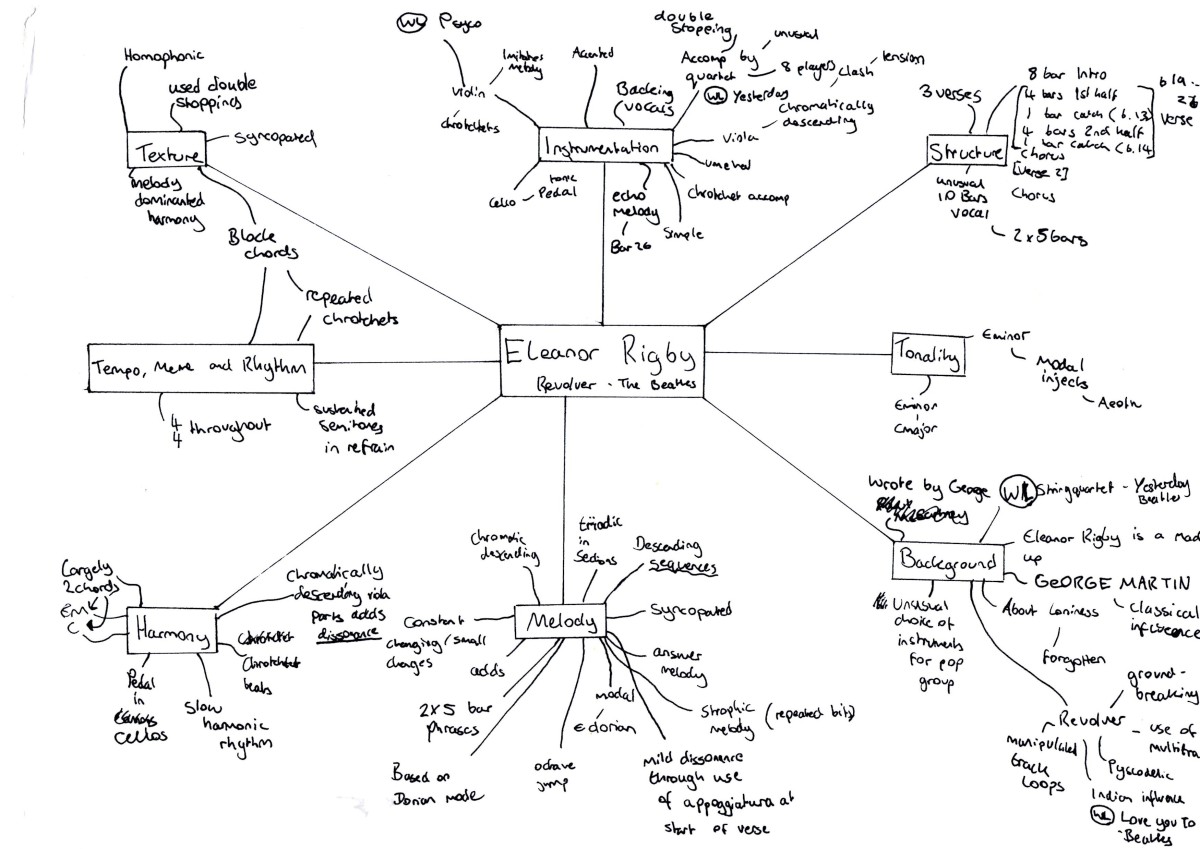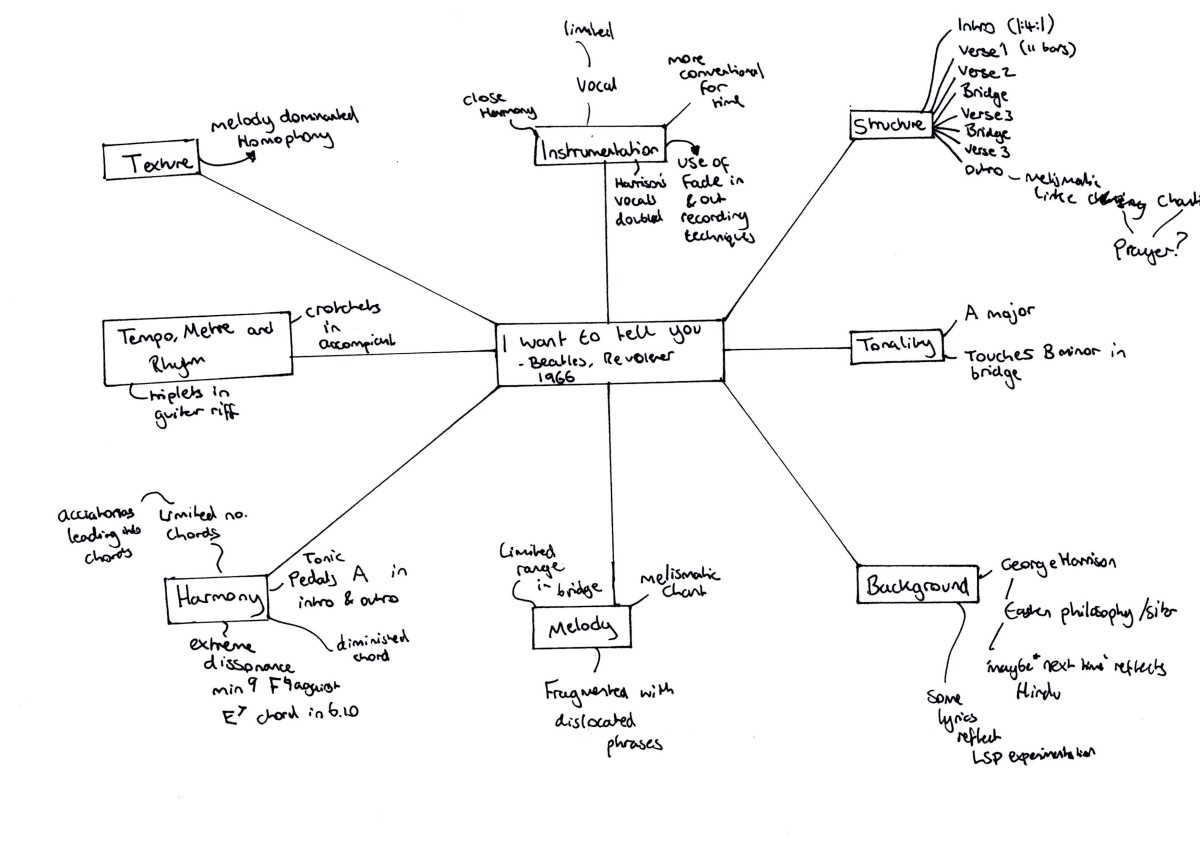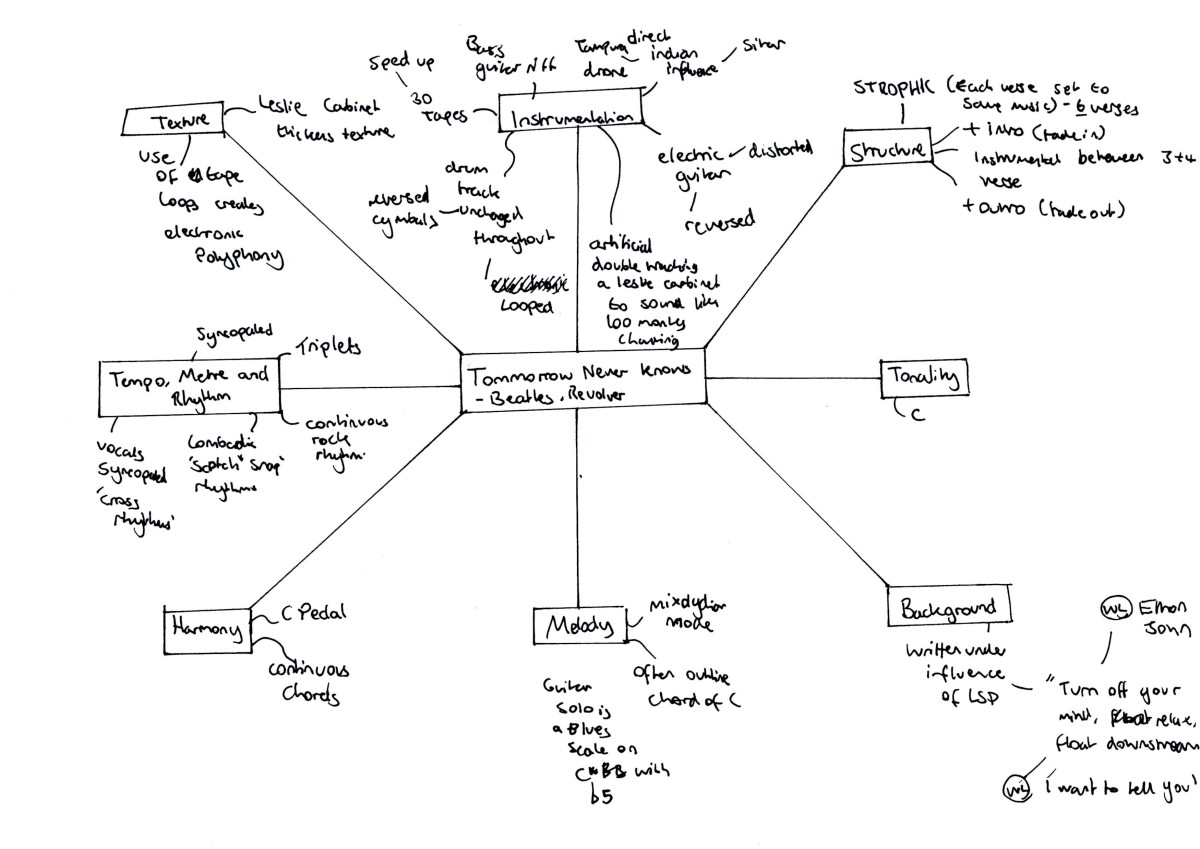Context
The Beatles were an English innovative rock band in the 1960s who stretched the limits of technology and pop writing, resulting in some of the most iconic music of the second half of the 1900s. The group was made up 4 performers, Paul McCartney, John Lennon, George Harrison and Ringo Starr. The lyrics and tunes were mostly composed by Paul McCartney and John Lennon, however some pieces, such as “I Want To Tell You” were composed by George Harrison. Ringo only occasionally composed. The Beatles producer, George Martin, influenced the group in style due to his classical training, resulting in instrumentation unused by other pop groups at the time.
General Wider Listening
- The Kinks – Waterloo Sunset: Features a popular song structure and common features, such as backing vocals, guitar riffs, a hook, melody-dominant homophony.
- Jeff Buckley – Grace: Features melody-dominant homophony, a guitar riff, word painting, dissonant chords for effect, grace notes, middle 8, audio effects, backing vocals
The songs that this post will cover are from their album, “Revolver” released in 1966.
- “Eleanor Rigby”
- “I want To Tell You”
- “Here, There And Everywhere”
- “Tomorrow Never Knows”
A revolutionary album, also by the Beatles, is “Sgt. Pepper’s Lonely Hearts Club Band” , released in 1967 and celebrated its 50th anniversary last year. The album took 129 days to complete but was thought to have changed music forever around the world due to its unique style. As with “Revolver” the Beatles had to invent instruments and new studio techniques to get desired results, only possible through the groups creativity. The BBC released a lot of information last year in terms of radio podcasts, blogs and TV documentaries.
Sgt Pepper’s Musical Revolution with Howard Goodall (Program)
The Beatles Sgt Pepper’s Lonely Hearts Club Band Review (Blog)
Sgt. Pepper Song Brief Analysis (PowerPoint) for Wider Reading/Listening
Eleanor Rigby
Lyrics
Eleanor Rigby is a song about loneliness and ageing. The lyrics “wearing the face she keeps in a jar by the door” (b. 15) is a reference to the cream she wears in order to make her look younger. At bar 62 the lyrics read “no one was saved”. This is indicates that she didn’t go to heaven as the church promises. This caused a lot of controversy amongst listeners.
Instrumentation
- Use of a string quartet – This was not common in pop music. George Martin influenced this decision due to his classical upbringing. There are actually 8 instrumentalists playing 4 parts, allowing for parts to split.
- String Techniques – Double stopping is used throughout the piece providing an almost “dagger-like” sound.
- Vocals – The lyrics are very powerful in this song. The phrases generally move in an arch in terms of pitch, however at some points there are big intervals of an octave and even a 10th (e.g bar 19, 24, 42). This provides contrast to previous phrases.
Structure
The structure of “Eleanor Rigby” is peculiar, with 10 bars as the vocals of each verse, instead of the more common 12 or 16 bar phrases. 3 verses and an outro
8 Bar Intro
10 bar Verse: 2x 5 bar phrases [“Eleanor Rigby picks up the rice…”] (b. 9)
8 bar Refrain [“All the lonely people…”] (b. 19)
10 bar Verse 2: 2x 5 bar phrases [“Father McKenzie writing the words…”] (b. 27)
8 bar Refrain [“All the lonely people…”] (b. 37)
18 bar Bridge containing features of the intro [“Ah, look at all the lonely people…”] (b. 45)
9 bar Refrain/Outro combing features of both [“All the lonely people…”] (b. 63)
Tonality
The piece is in Em only uses 2 chords, Em and C. The vocals are diatonic and there are modal injects (dorian and aeolian).
Melody
- The melody is strophic (repeats sections)
- Based on E dorian
- Uses descending sequences
- Triadic in sections
- Use of chromatic descent.
- Uses answer melodies.
- Mild dissonance in sections
- Distinctive leaps (b. 19)
- Syncopated
- Double Stopping
Harmony
- Made up of 2 chords, E minor and C major.
- Cellos play tonic pedals (b. 19 – 26)
- Violas play chromatically descending semibreves (b. 19 – 26). Adds dissonance.
- Slow harmonic pace – 3x bars of Em, 2x bars of C major
Tempo, Metre and Rhythm
- 4/4 time throughout
- Sustained semibreves in refrain.
- Repeated crotchet block chords.
Texture
- Melody dominant homophony
- Occasionally homorhythmic
Wider Listening
- Beatles – Yesterday [Use of string quartet]
- Bernard Herrmann – Psycho [use of strings]
- Jeff Buckley – Grace [use of melody dominant homophony]
- Beatles – She’s Leaving Home [Use of string quartet and string techniques]

Here, There and Everywhere
Written by Paul McCartney, this piece is a slow ballad with american influence, showed by the close barbershop vocal harmonies.
Instrumentation
- Reduced from standard pop song
- Guitars – spread chords in intro. backing guitar plays simple chords on 2nd and 4th beats
- leslie cabinet – to imitate a mandolin sound (b. 15).
- Vocals – of american influence (close harmonies). High range. (WL: Freddie Mercury). Backing vocals to harmonise.
- No drums.
Structure
Altered AABA structure (reduced to 28 bars)
Intro (unusal 3 bars)
|: Section A (8 bars) 😐
|: Section A (4 bars), Section B (8 bars) 😐
Outro (8 bar)
Tonality
- G major (b. 1 – 12, b. 17 – 24) -> Bb major (b. 13 – 16).
- G major and Bb major is a tertiary relationship.
- Section A hints at Em
Melody
- Free intro
- Syncopated
- Syllabic
- High vocal range (WL: Freddi Mercury)
Harmony
- Introduction chromatic. G, Bm, Bb, Am
- Section A: I, II, III, IV, V (Rising parallel chords in root position)
- Section B: I, VI, II, III, VI, II
- Chromatic slips
- Perfect cadence (b. 13)
- Plagal cadence at end.
Tempo, Metre and Rhythm
- Rubato section at start
- 7/8 metre at start (weird)
- Syncopated
- Guitar plays off beats
- Use of Scottish snaps
Texture
- Melody dominant homophony
- Guitar alters between block chords
Wider Listening
- The Beach Boys – God Only Knows [Close harmonies, weird key changes]
- The Beach Boys: Pet Sounds [American Influences] Documentary
- Jeff Buckley – Grace [melody dominant homophony]
I Want To Tell You
This song was written by George Harrison. George was influenced by eastern philosophy and instruments. “Maybe next time round” reflects the belief of reincarnation. This version above includes a twanky swanky guitar solo.
George learnt to play the sitar by Ravi Shanker. The song was written under the experimentation of the hallucinogenic drug, LSD, which was common in music from the 1960s.
Instrumentation
- Vocals – In close harmony, similar to american songs of the time. (WL: The Beach Boys). Backing vocals harmonise.
- Tapes – Use of fade in and fade out.
- More conventional at time.
- Piano – plays block chords.
- Tambourine, maracas and hand claps.
Structure
|: Intro (4 bars) 😐
11 bar Verse 1 (b. 5 – 15)
10 bar Verse 2 (b. 16 – 26)
8 bar Bridge (b. 27 – 34)
10 bar Verse 3 (b. 16 – 26)
8 bar Bridge (b. 27 – 34)
8 bar verse 3 (b. 16 – 25)
10 bar Outro (b. 36 – 45)
Tonality
- All in A major
- Touches B minor in bridge
Melody
- Backing vocals harmonise
- Long melisma at end gives a “chant-like” effect.
- Fragmentary with dislocated phrases.
Harmony
- Tonic pedal A in intro and outro.
- Extreme dissonance. the minor 9th (F♮) against E7 chord (E, G#, B, D) (b. 10).
- Use of acciaccaturas leading into chords.
- Limited number of chords (A, D, B, E, Bm, Bdim)
- Use of diminished chords (b. 28)
Tempo, Metre and Rhythm
- Crotchets in accompaniment.
- Triplets in guitar riff.
- 124 bpm.
Texture
- Melody dominant homophony (WL: Jeff Buckly – Grace)
- Use of tonic pedal
Wider Listening
- The Beach Boys – God Only Knows [Close harmonies, weird key changes]
- Jeff Buckley – Grace [melody dominant homophony]
- The Kinks (Popular format)

Tomorrow Never Knows
This song was written by John Lennon and is the most innovative song on the album, “Revolver“. It uses tape loops excessively. For this song, 30 separate tape loops were recorded. This song was the first written for the album, but it placed last on the album.
Lyrics
Some of the lyrics in this song are from a book called “The Psychedelic Experience: A manual based on The Tibetan Book of The Dead”. Most definitely a song about the use of LSD. “Turn off your mind, relax and float down stream“.
Instrumentation
- Drum Track – Unchanged throughout. Altered using studio effects – uses reversed cymbals.
- Indian Influence – Use of the sitar and tambura drone. Not done before in pop music.
- Electric Guitar – Reversed and distorted using tape manipulation.
- Bass Guitar – Plays a riff throughout.
- THE SEAGULLS – Spoiler Alert, not seagulls. Laughing was recorded, sped up, reversed.
- Superimposing
- Leslie Cabinet – Used to make vocals sound like “100 monks chanting”. Doubles Tracking.
Structure
- Strophic (Each verse set to some music)
Intro (Fade In)
|: 8 bar Verse 1 – 3 😐 (b. 7 – 14)
16 bar instrumental (b. 16 – 31)
|: 8 bar Verses 4 – 6 😐 (b. 7 – 14)
Outro (Fade out) (b. 32 – end)
Tonality And Harmony
- Continuous C major chord throughout.
- C pedal
Tempo, Metre And Rhythm
- Syncopated
- Continuous rock rhythm
Texture
- Leslie Cabinet thickens texture.
- Use of tape loops creates electronic polyphony.
Wider Listening
- The Beatles – Love You To (From Revolver) [Use of Indian Instruments]
- The Beatles – Within You Without You (From Sgt. Pepper’s Lonely Hearts Album) [Use of Indian Instruments]
- Oasis – Who Feel’s Love [Example of a modern band that have been influenced by the Beatles innovative style]

References
http://www.songfacts.com/detail.php?id=102
http://www.songfacts.com/detail.php?id=114
Something weird and cool I found:




